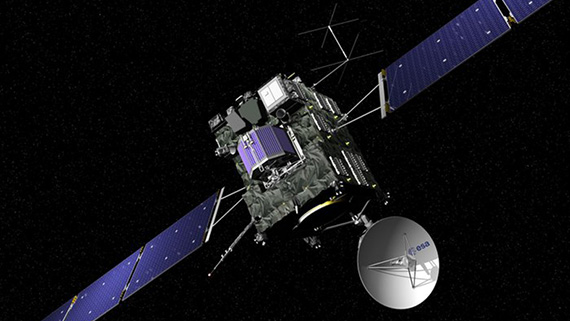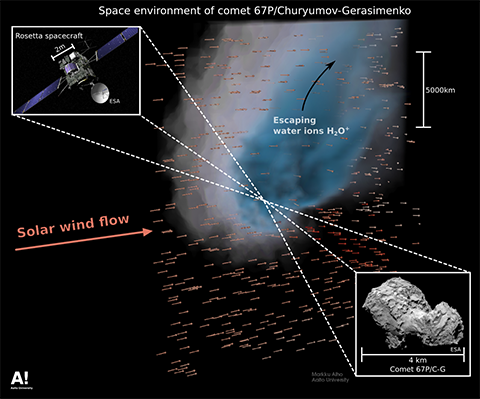The Rosetta probe witnessed the awakening of the icy comet

Professors Esa Kallio from Aalto University and Hannu Koskinen from the University of Helsinki have been analysing the Rosetta probe's measurements of the comet 67P/Churyumov-Gerasimenko since August 2014. The first water vapour jets from the comet were observed in September 2014, i.e. very early in the comet's awakening stage. The findings surprised the researchers.
- We were really surprised that the water vapour from the comet was able to disrupt the solar wind significantly, even though the comet was still a long way from the warmth of the Sun. At the start of the measurements, the comet's distance from the Sun was more than three times the distance between the Earth and the Sun, explains Professor Esa Kallio.
On the basis of the measurements, the Finnish group was also able to estimate that the comet was losing water at a rate of about one kilogramme a second. Professor's findings were published on 23rd January in the prestigious Science Magazine.
The research of Professor Kallio's group focussed on interpreting the material produced by the spacecraft's Ion Composition Analyzer (ICA). The ICA particle measurement device is one of five sensors in the Rosetta Plasma Consortium and it measures when the comet starts to produce water vapour jets and the electrically charged light particles they generate. The Finnish Meteorological Institute has participated in building the ICA since the mid-1990s under the direction of research manager Dr. Walter Schmidt.
Understanding through modelling
The spacecraft, which has been placed in the comet's orbit, has eleven scientific measurement devices which take an array of measurements of the comet's development as it nears the Sun.
As they separate the particles form the comet's tail, and for the first time it will now be possible to measure its growth from its formation to its decline. The ICA was witnessing the awakening of the icy comet by the Sun and the formation of vapour before Rosetta's Philae lander was released and transmitted new data about the erosion of the comet's surface.
- The particles leaving the tail give information about the comet's space weather i.e. the comet's environment in space where the heat induced by sunlight and the solar wind together erode the surface of the comet, explains Professor Kallio.
Professor Kallio and his research group analyse the measurements from the spacecraft using a three dimensional computer simulation.
- The modelling we use significantly deepens our understanding of the measurement data we receive. You cannot develop a holistic picture of events on the comet simply by taking measurements at individual locations, nor by using a single measurement instrument. The only way is by analysing and combining measurement results and using them to create a model.
In addition to gas generated from the ice, other material also leaves the comet's surface. Professor Kallio's research group hopes to get some heavy dust particles to examine later. The next phase of the research work is to compare results with those from other measurement instruments.
- We are focussing particularly on the fluctuations in the intensity of erosion during the lifecycle of the comet. The intensity of erosion is thought to increase as the comet approaches the Sun and is presumed to be at its maximum in August 2015. That is why we expect more vapour jets as the summer approaches.

Photo: Markku Alho / Aalto university
Further information:
Research Manager Dr. Walter Schmidt, Finnish Meteorological Institute tel. +358 (0)29 539 4658, Walter.Schmidt@fmi.fiProfessor Esa Kallio, Aalto University tel. +358 (0)50 4205 857, Esa.Kallio@aalto.fiProfessor Hannu Koskinen, University of Helsinki tel. +358 (0)50 4155 356, Hannu.E.Koskinen@helsinki.fi
Link to the magazine: http://www.sciencemag.org/content/347/6220/aaa0571.full
An animation based on modelling by Professor Kallio's research group and other material can be seen here: http://space.aalto.fi/news/pub-science-2015-01-23.html
Rosetta is the cornerstone programme of the European Space Agency. The Rosetta spacecraft is composed of the orbiter and the Philae lander. The Rosetta orbiter will follow the comet 67P/Churyumov-Gerasimenko at least until the end of 2015. As Rosetta orbits the comet it carries eleven scientific measurement instruments which are continuously providing historical data about the comet and its development. In Finland the Finnish Meteorological Institute participated in the construction of the ICA and Aalto University and the University of Helsinki are working on interpreting the measurement data. The measurements are expected to increase our knowledge of the initial moments of the creation of our solar system when the comets were born. Comets are also interesting because comets colliding with the Earth brought water with them and possibly organic molecules.
